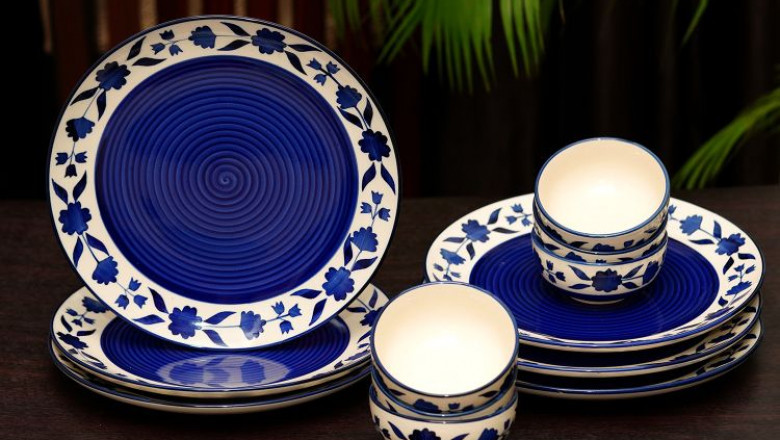views
Plates and bowls are more than just functional dining tools; they’re integral to the presentation, serving style, and even the overall ambiance of your dining experience. With an array of options available in terms of shapes, sizes, materials, and designs, it’s important to understand the variety of plates and bowls and their specific uses. Whether you’re hosting a dinner party or enjoying a casual meal, selecting the right type ensures that your dining experience is both practical and visually appealing.

Here’s a detailed exploration of the different types of plates and bowls to help you choose the perfect ones for every occasion.
Types of Plates
1. Dinner Plates
- Size: Typically 10 to 12 inches in diameter.
- Purpose: Used for main courses during lunch or dinner.
- Designs: Available in round, square, and even oval shapes, with plain or patterned surfaces.
2. Salad Plates
- Size: Smaller than dinner plate, usually 7 to 9 inches.
- Purpose: Ideal for serving salads or light snacks.
- Material: Commonly made of porcelain or stoneware for durability.
3. Dessert Plates
- Size: Around 6 to 8 inches.
- Purpose: Used to serve desserts, such as cakes, pastries, or fruit.
- Tip: Choose designs that complement your dessert presentation for an elegant touch.
4. Appetizer Plates
- Size: Small, usually 4 to 6 inches.
- Purpose: Perfect for serving starters or finger foods.
- Material: Often lightweight for easy handling during cocktail parties.
5. Charger Plates
- Size: Larger than dinner plates, around 13 to 14 inches.
- Purpose: Used as decorative base plates during formal dining to hold other plates.
- Note: Charger plates are not used for direct food serving.
6. Serving Plates
- Size: Varies depending on the dish size.
- Purpose: Designed for family-style dining to hold large portions of food.
- Material: Durable materials like melamine, stainless steel, or ceramics are common.
Types of Bowls
1. Soup Bowls
- Capacity: 12 to 20 ounces.
- Purpose: Deep bowl designed to hold liquids like soups or stews.
- Styles: Rimmed bowls for formal dining and rounded ones for casual meals.
2. Cereal Bowls
- Capacity: 10 to 16 ounces.
- Purpose: Ideal for breakfast cereals, oats, or fruit salads.
- Material: Lightweight options like melamine or glass are preferred for everyday use.
3. Pasta Bowls
- Shape: Wide and shallow with a slightly raised edge.
- Purpose: Perfect for serving pasta dishes, risottos, or salads.
- Advantage: Combines the functionality of a plate and bowl.
4. Rice Bowls
- Size: Smaller, typically 6 to 8 ounces.
- Purpose: Designed to serve rice, especially in Asian cuisine.
- Design: Often features intricate patterns or designs.
5. Mixing Bowls
- Capacity: Large bowls with up to 5 liters or more.
- Purpose: Used for preparing and mixing ingredients.
- Material: Stainless steel, glass, or plastic for durability and ease of cleaning.
6. Serving Bowls
- Size: Larger and deeper than regular bowls.
- Purpose: Ideal for holding salads, soups, or curries during group meals.
- Tip: Match them with your plates for a cohesive dining set.
Factors to Consider When Choosing Plates and Bowls
1. Material
- Ceramic: Elegant and suitable for formal dining but prone to chipping.
- Porcelain: Lightweight, durable, and versatile.
- Stoneware: Heavier, rustic-looking, and durable.
- Melamine: Perfect for outdoor dining as it’s lightweight and shatterproof.
- Glass: Modern and stylish but can be fragile.
2. Shape and Design
- Round plates and bowls are classic and versatile.
- Square or rectangular options bring a contemporary touch.
- Patterned or embossed designs add personality to your dining table.
3. Size
- Ensure the size of your plates and bowls fits your cabinet space.
- Opt for stackable designs for efficient storage.
Creative Uses for Plates and Bowls
Decorative Purposes
- Use elegant plates as wall décor in your kitchen or dining area.
- Arrange bowls with flowers or potpourri as a centerpiece.
Meal Presentation
- Serve desserts on square plates for a modern aesthetic.
- Use rimmed bowls for layered salads or soups to enhance visual appeal.
Multifunctional Use
- Bowls can double as snack containers for movie nights.
- Charger plates can act as trays for serving beverages.
Maintenance Tips for Plates and Bowls
Cleaning
- Wash porcelain and ceramic dinnerware with mild soap to avoid scratching the surface.
- Use a dishwasher for convenience, but ensure the pieces are dishwasher-safe.
Storing
- Stack similar sizes to save space.
- Use plate or bowl racks to prevent scratching or chipping.
Handling
- Avoid exposing delicate materials like glass or bone china to extreme temperature changes.
- Handle stoneware carefully as it may chip if dropped.
Why Invest in High-Quality Plates and Bowls?
Investing in premium plates and bowls not only elevates your dining experience but also ensures durability and functionality. A well-chosen dinnerware set can last for years and add sophistication to your dining table.
Understanding the different types of plates and bowls and their uses can transform your dining experience. Whether you’re a culinary enthusiast or someone who loves hosting, selecting the right plates and bowls tailored to your needs and style ensures that every meal is both functional and delightful. Explore the variety of options available, and invest in pieces that reflect your personality and elevate your dining table.






















Comments
0 comment